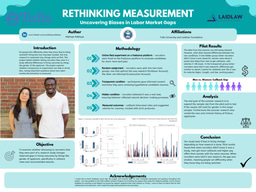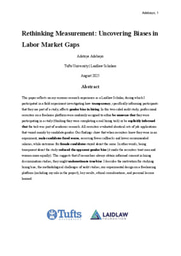Project Outline: Rethinking Measurement: Uncovering Biases in Labor Market Gaps
Measuring Labor Market Inequality: How Methodology Shapes Our Understanding of Bias
Supervised by: Professor Laura Gee, Department of Economics at Tufts University
Hey everyone! My name is Toye Adebayo, an undergraduate researcher and Laidlaw Scholar at Tufts University. This summer, I’m conducting research that explores how different methods of measuring labor market disparities, based on gender, race, and criminal record, can influence the conclusions we draw about inequality itself. While much of the public conversation focuses on whether or not bias exists, this project asks a more fundamental question: how does the way we measure bias shape what we see?
In collaboration with Professor Laura Gee from the Tufts Department of Economics, our research investigates whether certain measurement strategies unintentionally understate or overstate true levels of discrimination in hiring. We hope this work will shed light on how to design more accurate and impactful approaches to understanding labor market inequality.
Methodology
To study this, we’re running a large-scale audit experiment on a major online hiring platform, Upwork. We will send over 17,000 tailored job requests to trained recruiters, each featuring professional-looking resumes that differ by key characteristics, such as racial or gender-associated names, and the presence or absence of a criminal record. The resumes will be matched in qualifications to isolate the impact of perceived identity.
A unique feature of this study is the use of two groups: one where recruiters know they are participating in a study, and another where they do not. This will allow us to measure the extent to which awareness of being observed influences decision-making. For example, do recruiters behave more fairly when they know they’re being studied?
Responses will be analyzed based on acceptance rates, response times, and message content, offering insights into both explicit and implicit bias. We’ll also compare results across measurement conditions to assess how the method of data collection itself may alter our understanding of disparities.
Goals
The core objective of this research is to determine how different methods of measuring labor market inequality affect the accuracy and visibility of those disparities. In doing so, we aim to:
- Uncover whether recruiters behave differently when they are aware of observation.
- Identify patterns of bias in recruiter decision-making across gender, race, and criminal record.
- Evaluate how methodological choices influence the conclusions we draw from field experiments.
I’m incredibly excited to be a part of the Laidlaw community this summer and to contribute to a broader understanding of fairness in labor markets. Please feel free to reach out if you're interested in labor economics, experimental methods, or equity in hiring. I’d love to chat!


Please sign in
If you are a registered user on Laidlaw Scholars Network, please sign in